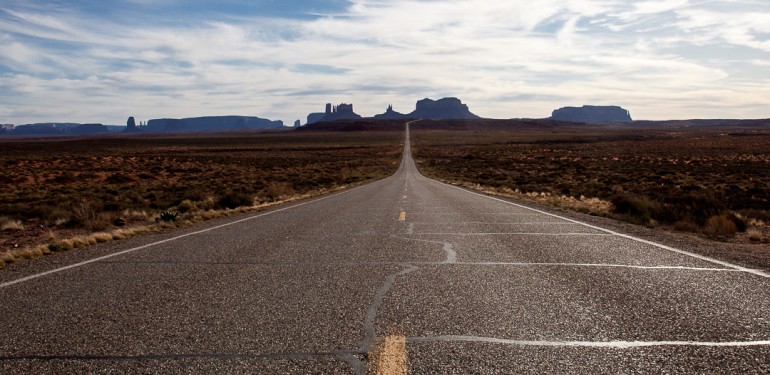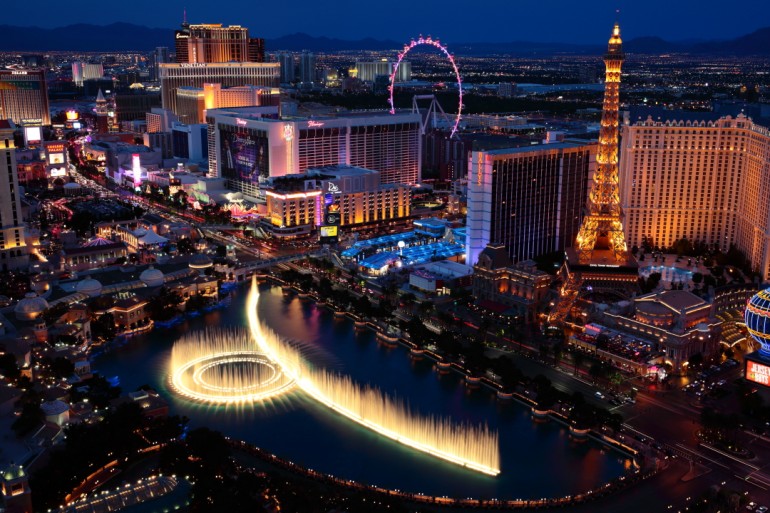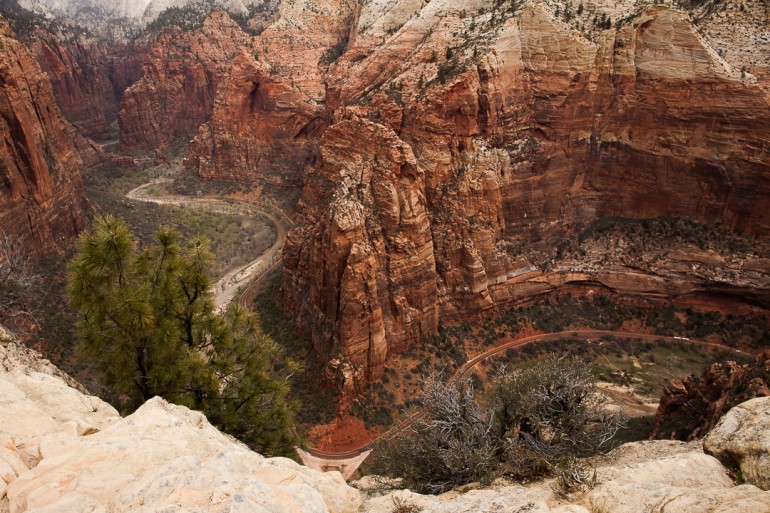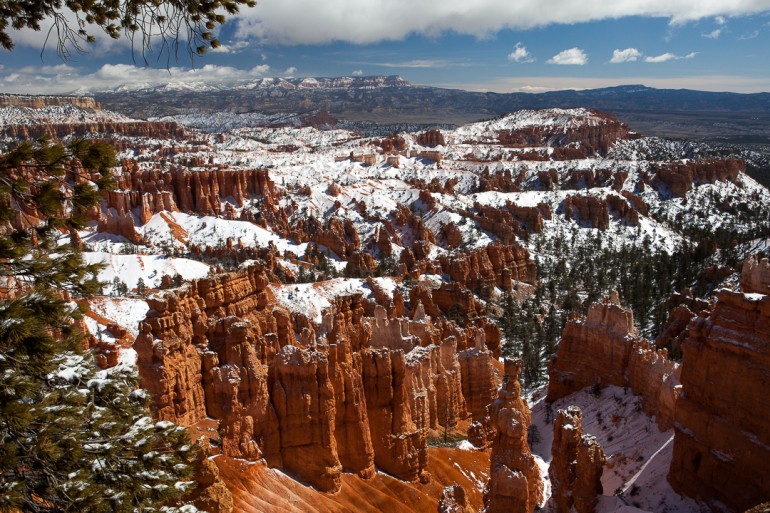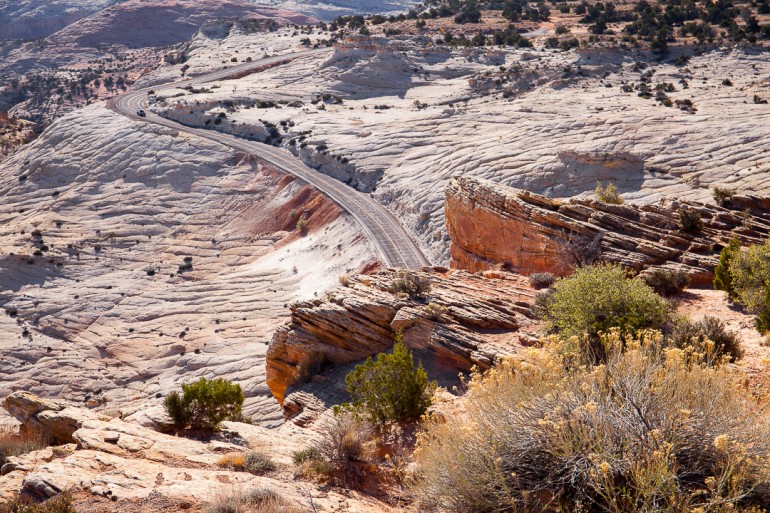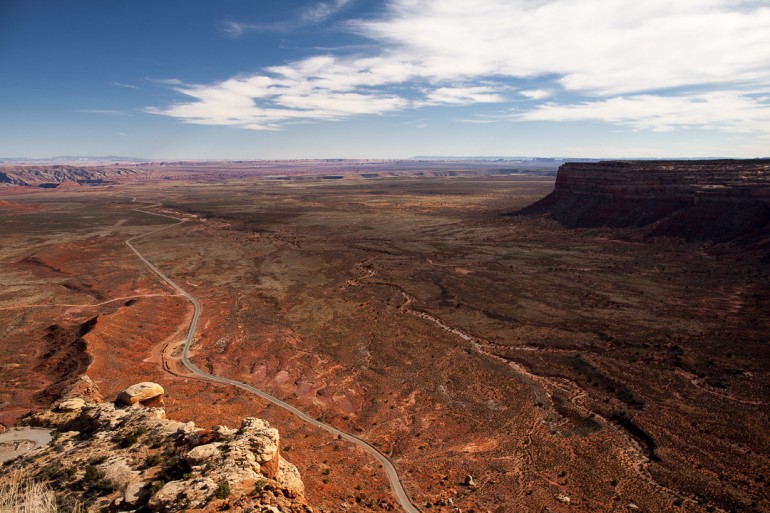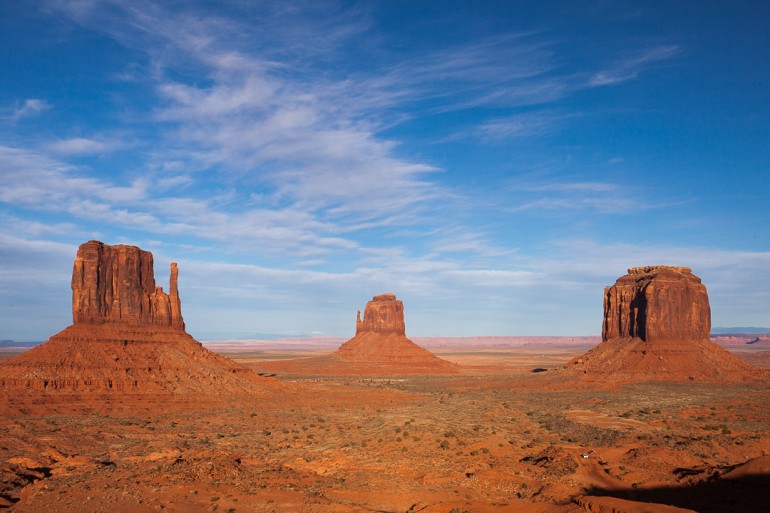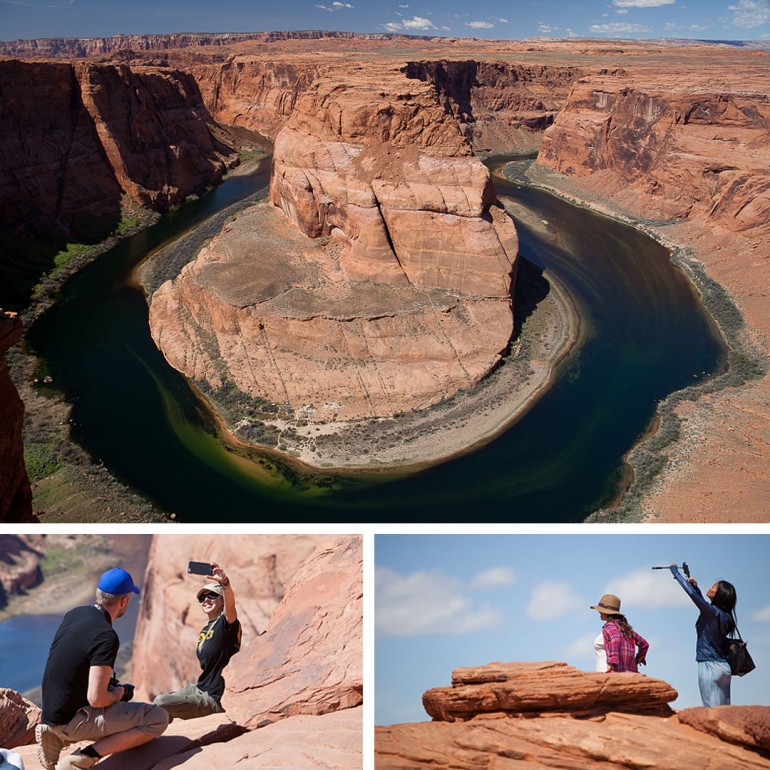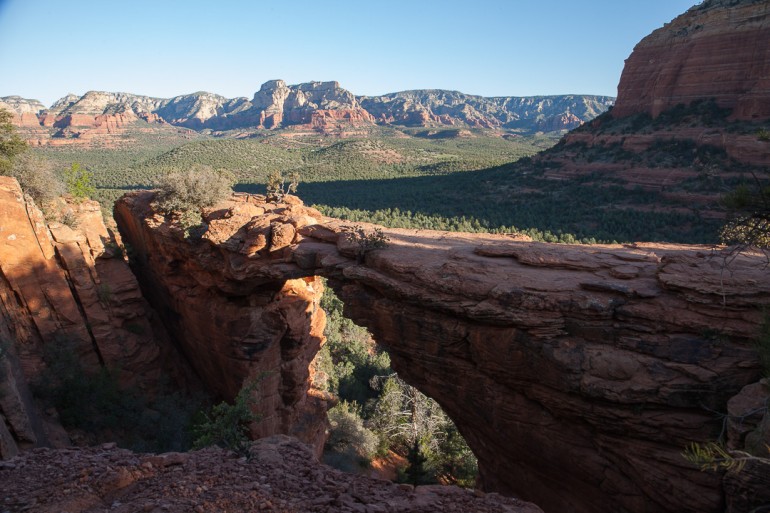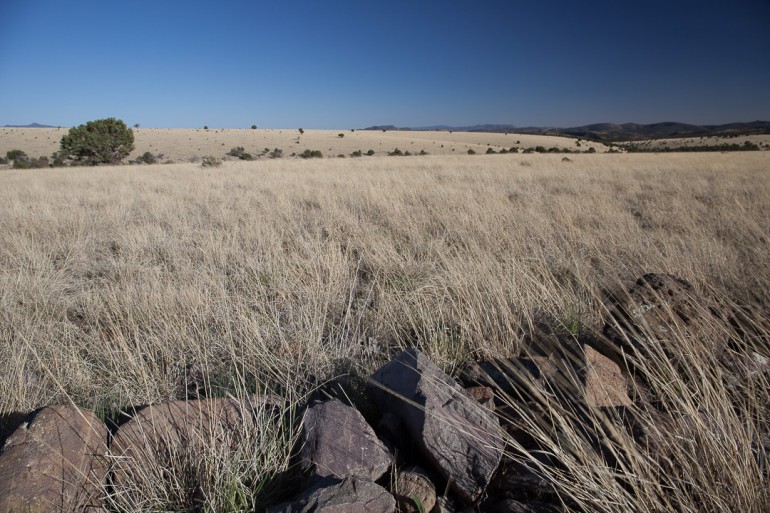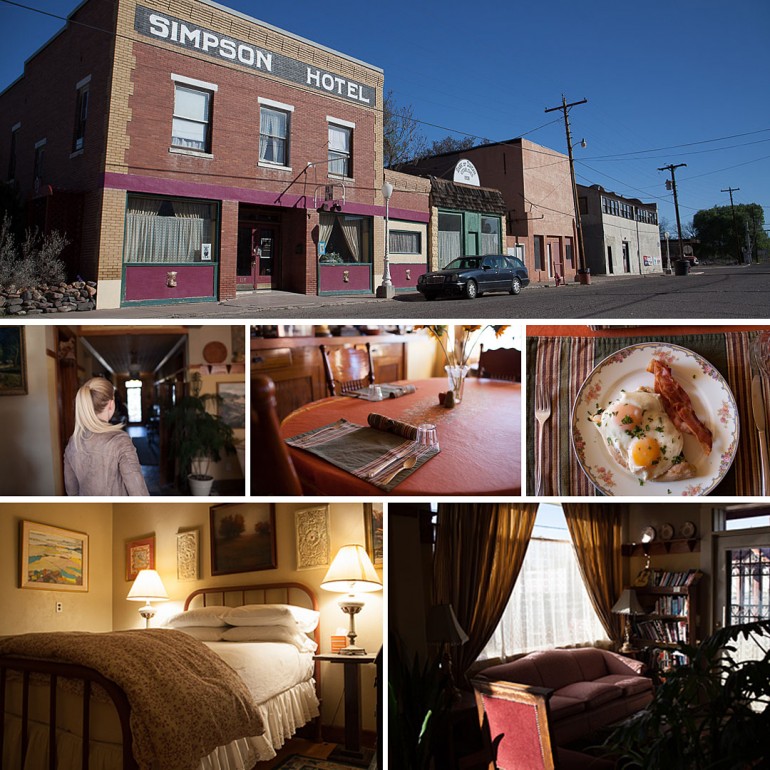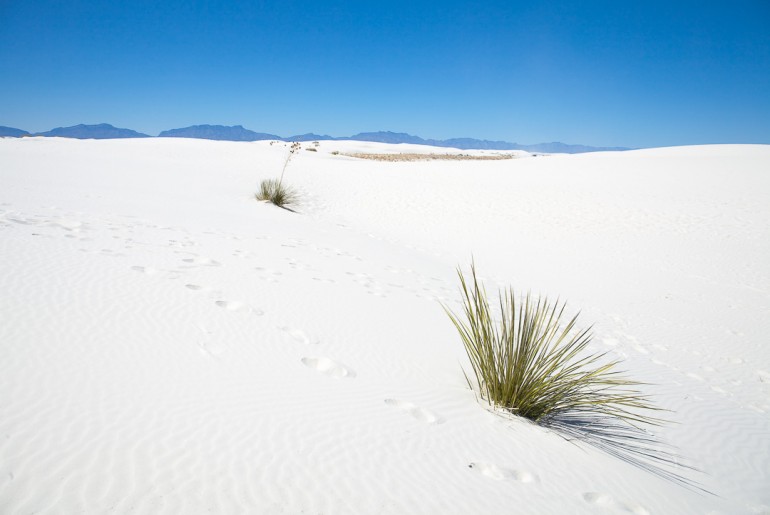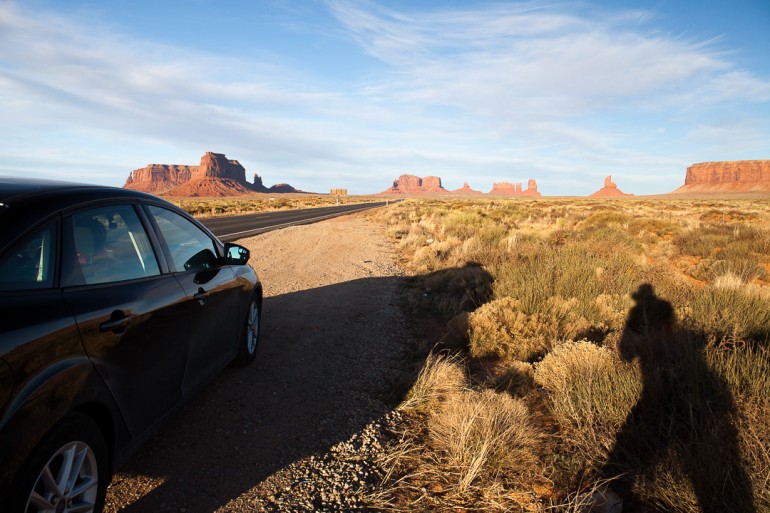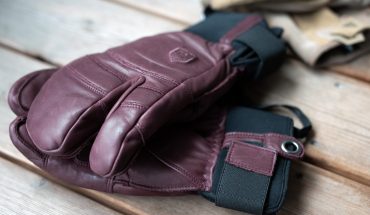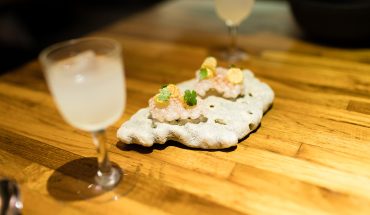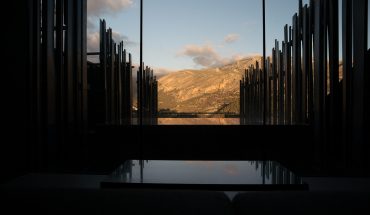The American Southwest is known for its vast expanses and whether you like it or not, a car is the way to get around. The friendly and unstressful atmosphere is just one reason to take some time to explore this area, another is the abundance of national parks and then of course the food and unique hotels. This drive starts in Las Vegas and ends in Austin, going through Nevada, Utah, Arizona and Texas along their way. We’ll find some great scenery, curvy drivers roads, quirky hotels and fabulous food. What more is there to ask for?
See our Southwest Road Trip Guide for a more structured overview over our travel tips for the area
This Southwestern road trip is 7 days long and spans some 2100 miles with 38 hours of driving. It will give a good variation of city life at the start and finish with mostly nature in the middle. Add extra days where needed or take further detours or rests to really explore the areas that are being passed.
The best time to do this is either spring or fall since the temperatures will be much more pleasant than during full summer, but going too early in the year can make it tough to visit Bryce Canyon since the altitude means a real chance for snow and temperatures below freezing. On the other hand, dress right and Bryce will be exceptionally beautiful and provide a slightly more unique experience than most will encounter.

Map from Las Vegas, Nevada to Austin, Texas for the 2100 mile road trip. Click to open the map in Google Maps.
While most associate Southwestern USA with a flat, rocky desert, the landscape is actually quite varied and the higher you get, the more vegetation and bigger trees there’ll be. Southern Utah is composed of several plateaus in the Grand Staircase-Escalante National Monument Area, with the highest point on this trip some 9600 feet above sea level. The changes in altitude also makes for vastly more exciting roads than the common, arrow straight interstates. This area is litterally filled with national parks, national monuments and national forests and other places that invites to spending time outdoors. You can easily spend weeks, or even months, just in this area to explore the different places. Entry to the national parks is usually $30 per vehicle and is good for 7 days, a national annual pass is $80 and it’s possible to upgrade a single park entry into an annual pass at any national park or monument within the 7 day period.
New Mexico and Texas is much flatter with straighter roads than Utah and Arizona, but civilization can be equally spread out. Always keep a couple of hours of reserve in the gas tank and bring snacks and water on the trip, if you miss a place to buy a coffee and a bagel you will often have to wait several hours until the next opportunity. The nature in this area is not impressive in the same way as further north and west, but there are things to look for along the road that can be worth the journey in itself. The Judd Foundation galleries in Marfa, Star Axis and The Lightning Field are some of the art destinations which could only exist in these vast expanses.
One practicality that can be confusing while driving this route is the time differences. Utah (Mountain Time Zone, UTC -7 hours) is one hour ahead of Nevada (Pacific Time Zone, UTC -8 hours) and they both observe daylight savings time. Arizona does not observe daylight savings time so they are sometimes on Pacific and sometimes on Mountain time. The Navajo Nation, which lies mainly within Arizona, does observe daylight savings time which adds to the confusion when crossing the time zones. New Mexico is on the Mountain Time Zone and Texas is on the Central Time zone (UTC -6 hours).
Day 0: Las Vegas, NV
Whenever we have the chance, we like to visit Las Vegas. The never ending line up of great restaurant combined with all kinds of other experiences just makes it a great place to visit. Whether you rent a car or come here with your own, there are a few excursions that’s worth exploring. Hoover Dam is only a 45 minunte drive away and is a classic, if not a must. But going north west of Las Vegas to Red Rock Canyon makes it possible to stop at Bachi Burger in Summerlin for some of the best burgers in the world. The asian influenced burgers and burger food hits the spot on creativity, concept and execution. The location is not as exciting as the food, otherwise this could be one of the best casual food restaurants on the planet.
Among the bigger casino resorts on the Strip, our top pick is the Cosmopolitan even though the rest of the hotels at the City Center all have their unique selling points. Among the other resorts, Wynn and Encore provide a more classic, luxurious experience with whimsical art and to keep them interesting. At the Cosmopolitan they have really nailed their restaurant selection. For a light meal China Poblano is fantastic, after a pool party the shakes and buns at Holstein’s are hard to beat, for an upscale meal that doesn’t break the bank Scarpetta is the best place in town and for one of the ultimate culinary experiences around, É by José Andrès is the place to go.
Of course, Sage and Twist are still on our list of must visits for any foodie. For more on Las Vegas, you can easily spend weeks even if you’re not into gambling, head over to our Las Vegas Travel Guide.
Except for having a good time, it’s also a good idea to stock up on snacks, water and other supplies. There will not always be a suitable place for lunch along the way, so a good supply of energy bars and jerky is recommended to bring along.
Day 1: Las Vegas, NV to Bryce Canyon, UT via Zion National Park, UT
Zion National Park is only two and a half hours away from Las Vegas, so start early and you will have plenty of time to get there well before lunch. Jean Philippe Patisserie at the Aria (and Bellagio) and Bouchon Bakery at the Venetian both open at 06:00 AM. Bring some baked goods to eat on the road or get up really early and have a more solid take on diner classics at The Henry at the Cosmopolitan.
When reaching Zion National Park, park at the main parking lot by the visitors center. It’s possible to drive a little further, but you still need to take the bus shuttle up into the main valley. The parking lot fills up quite early so you have to be there before 10:00 AM Utah time (one hour is lost when going from Nevada). When the parking is full it’s still possible to park anywhere in Springdale and take a free shuttle bus to the visitors center.
During winter the road into the valley is open, but to avoid crowding it’s closed for private vehicles roughly from March to October. Much of Zion National Park is centered around the central valley, with most of the hiking trails starting close to the bus stops.
One of the most iconic hikes at Zion is the Angels Landing trail. Take the shuttle to the Grotto and then head over to the other side of the road. The trail is very well marked and could almost be described as an exhaustive walk on even, but steep, ground until the final ascent up to the top starts. No special equipment or navigational skills are needed, but a word of warning. There are really steep drop-offs and the trail can be quite crowded so anyone having a hard time leaning out a window in a high-rise should think twice before going the final stretch.
For anyone who can manage heights and aren’t stressed by other people, the payoff is worth it. Looking over the valley is a magical experience, it’s grand, serene and beautiful at the same time. From start to finish it’s roughly a four hour hike in a calm tempo but without unnecessary stops.
After a quick break for snacks it’s time to get going to Bryce Canyon. It’s only one and a half hours away with the first stretch going through Zion. Just continue the road leading into the park and hold right when the closed road for the main valley forks left. The entire drive is beautiful and the landscape so vastly different from the desert around Las Vegas. You can feel the gain in altitude as the air cools.
Day 2: Bryce Canyon, UT to Escalante, UT
55 min, 49 miles or 3h 40 min, 114 miles (via Peek-a-boo slot canyon)
Most of the lodging and hospitality around Bryce Canyon is still run by the family who started Ruby’s Inn in 1916 and has been providing a base for visitors ever since. They now have multiple restaurants, two hotels (Ruby’s Inn and Bryce Canyon Grand Hotel) as well as the RV camping, general store and the “old” town. This little settlement is very close to Bryce Canyon so there will be no transfer time when setting out into the park.
The normal season for visiting Bryce Canyon is May to October. In March there’s probably freezing temperatures and a risk for snow so some heavier clothing than needed on the rest of the trip is required. Some think that Bryce Canyon is even more beautiful in this state, but it’s cold and not all of the hiking trails are open. The hoodoos themselves have been formed mostly by frost-wedging which break off pieces of rock, together with weathering and erosion. The resulting area of rock statues is unique and amazing to look at from around the rim or to go down into.
There are two suggestions for this day: either take a longer hike in Bryce Canyon and then go directly to Escalante, or start with a shorter hike before going to the Peek-a-boo and Spooky Gulch slot canyons. For the first version, the Fairyland Loop Trail is one of the classics in Bryce Canyon. It’s a fairly strenous 8.3 mile hike down into the amphithteater and back up. For the second version the Navajo Loop Trail is a short (1.8 mile) introduction into the hoodoos of the amphitheater. It starts at the Sunset Point parking area where many of the iconic photographs of Bryce Canyon have been taken.
Peek-a-boo and Spooky Gulch are two slot canyons providing a much more relaxed setting than the stress and hordes of visitors at Antelope Canyon. The loop hike starting with Peek-a-boo and ending with Spooky Gulch is 3.5 miles long, and even though Antelope might be more spectacular Peek-a-boo was deemed good enough as a setting for Nina Agdal in the “Natural Beauty” feature of Sports Illustrateds Swimsuit Edition 2015. Bryce Canyon and Monument Valley can also be spotted as backdrops in the photographs by James Macari. A little word of warning, Spooky Gulch is tight. A normal sized adult should have no problem getting through, but pregnant women and those who can’t bend so well might have some trouble.
These slot canyons are quite easily accessible from a parking spot on the Hole-in-the-Rock Road, but you’ll need a high ground clearance vehicle with four wheel drive to feel certain you won’t get stuck on the loosely packed dirt road.
Escalante is not big but it’s a very friendly little town catering to outdoor enthusiasts in addition to the local population. For a slightly more unique take on accomodation than a motel the Shooting Star RV Resort provides Airstream trailers which can be rented by the night. The Outfitters Café is not something you expect to find in the middle of nowhere like this, the coffee is exceptional and the baked goods might not have the sophistication of Bouchon or Jean Philippe but the rugged execution combined with true feeling for the craft is very appropriate for the setting – and the really sticky, huge cinnamon rolls provide enough energy to recover after a long hike.
Also providing much better standards than expected is the Circle D Motel and Eatery. There are multiple areas worth visiting in the area so it wouldn’t be a problem to fill up more days with adventures. This part of Utah is also known for having very clear skies, partly due to the altitude, so all fans or star gazing or star photography can get their fix.
Day 3: Escalante, UT to Monument Valley, AZ
Waking up refreshed, stocking up in the general store and after getting some breakfast and road food from Outfitters Café it’s time to continue on the Scenic Byway 12. This is one of the most beautiful roads in the world and even though it starts close to the Red Canyon west of Bryce it really kicks up things up a notch east after Escalante.
Even after the number 12 ends and becomes Utah State Route 24 and 95, it’s one of the most magical drives possible. A good stop along the way is the Natural Bridges National Monument if there’s time to spare. When driving this stretch you’re constantly blown away by the views that are out of this world, and the grand finale is the vista down over Valley of the Gods and Monument Valley from the top of Moki Dugway at the Muley Point Overlook.
The Moki Dugway is quite exciting in itself, it’s basically a 10% gradient, switchback dirt road carved out from the side of the mountain. It’s fairly wide but the drop offs are huge and there are no guard rails. Soon it’s quite evident that Monunment Valley is approaching. Giant, isolated rock formations can be seen in the distance and the landscape transforms into a rocky desert.
There are a couple of hotels and lodges spread out in the area, with a few in Mexican Hat and Goulding’s Lodge really close to the park, but The View Hotel is located inside the actual Monument Valley Navajo Tribal Park where the start to the scenic drive loop is located and also one of the most beautiful, and iconic, views of the giant sandstone hobbes reaching up to 300 meters towards the sky is. Since this is not a national park a separate fee has to be paid even if you have a national park annual pass.
The scenic drive closes at 4:30 PM in the off-season (October to April) even though it’s possible to pay and drive in to the hotel and viewing spot later. The drive can be quite bumpy and loose so a high clearance vehicle can be a good idea to use.
Day 4: Monument Valley, AZ to Sedona, AZ via Page, AZ
Goulding’s Lodge, opposite the entry to Monument Valley park, provides a varied choices for a solid, although not exactly sophisticated, breakfast before starting Day 4’s adventures. During the first stretch it’s quite evident that the landscape changes and that the freestanding monoliths give way for the grand canyon and other types of natural processes to shape the rock.
Page is the starting point for many tours to Antelope Canyon, for which you need a guide in contrast to Peek-a-boo and Spooky Gulch, and the Horseshoe Bend is on US-89S just south of the town. The accessibility means that there are lots of visitors to these natural attractions and the stop also means that the light is not that fascinating. But the Bend is impressive and it can be quite fun just sitting and looking at people taking their selfies while eating a lunch pack.
16 miles northwest of Page is also the Amangiri by Aman resorts. For any fan of the juxtaposition of modern architecture and natural beauty, especially of the type found in Utah and Arizona, Amangiri is basically as good as it gets. For serenity, a wish to live in a complex fit for a Bond villain for one day or to experience one of the world’s ultimate luxury destinations, this is the place to sneak in an extra day – or week.
A good spot for an early dinner is the Lumberyard in Flagstaff. Flagstaff really feels like a gateway to Sedona, and after an increase in traffic and a in increasing density of man made buildings the actual downtown is really inviting in a modern, hipster way. The Lumberyard is an award winning brewery with contemporary takes on diner favourites. The fried Mac-N-Cheese balls might not be the most healthy thing in the world, but ticks most of the foodie boxes when eaten together with one of the craft beers on tap.
When exiting Flagstaff the scenery changes once again. The road snakes through a beautiful forest which you have plenty of time to take in together with the rest of the late day traffic. The town of Sedona is well established and much bigger than the civilization surrounding the other natural attractions on this trip. The main valley feels like something out of Jurassic Park and there are different starting points depending on the hike or view of choice, with many combinations possible.
There are lots of motels and hotels to choose from in the area, Sedona Motel has a good location but is quite expensive for what it is. Located just across the road is the Creekside Coffee & Bakery which serves coffee one step above most establishments and also home baked goods.
If you have a day or two to spare, Phoenix is a 2 hour drive south and could be a good detour for a city break. The Sanctuary on Camelback is an upscale resort located in beautiful grounds in Scottsdale worth looking up.
Day 5: Sedona, AZ to Duncan, AZ via the Coronado Trail Scenic Byway, AZ
One easy hike with a little push towards the end, and a nice pay-off, is the Devil’s Bridge. This hike is short and sweet, 0.8 miles one way, up a wide and well used trail towards the side of a mountain. To take the “pure” version, a 4WD vechicle with good ground clearance is needed to reach the parking spot on the Dry Creek Road. A more accessible start along paved roads is the Mescal Trailhead on the Long Canyon Rd. The result is a 4 mile roundtrip first following the Chuck Wagon Trail east and then crossing the road to the Devil’s Bridge Trail. The hike is very well marked and one look at Google Maps is enough preparation, but bring water and snacks.
Starting at sunrise, around 6:30 a.m. in March, is highly recommended. The most important reason is that the views over the valley as the sun climbs is spectacular, the other is that this hike is very popular and will be crowded fast. The whole area has so much to give that a one night and one short hike might be too little, but it does give a good taste of what Sedona has to offer.
Feeling refreshed by the morning hike, take a breakfast at Creekside Coffee & Bakery before going on an epic drive south on the US-191. The 121 mile stretch between Springerville and Clifton is called the Coronado Trail Scenic Byway, but is also knows as the “Devil’s Highway” from the old numbering (US-666). It’s listed as the curviest road in the U.S. by the Federal Highway Administration and there’s no denying it’s a curvy road as the elevation changes from the start at 7000 feet to a maximum at 9000 feet and then ending at 3500 feet.
Although there are a good number of stretches with 10 mph switchbacks, there should be around 450 of these if you count, but most of the road is more flowing with extremely limited amounts of traffic. There are nice views over the forested area and hardly any civilization at all. The Bear Wallow Café in Alpine (42650 US-180) is one of the last outposts before the really desolated stretch begin. They serve classic Southwestern fare together with fantastic dessert pies for which they are quite known.
Close to the end of the road one of the world’s largest open pit mines is located. The Morenci copper mine is one of those things you only see on the Discovery channel and wonder where they are located in the real world. It’s utterly fascinating watching the hundreds of gigantic vehicles looking like small ants as they make the whole complex work as one integrated organism. The entire economy in this area is tied to the ebb and flow of mining, and has been since the 1880’s when the mine was first opened.
Just 30 miles south of Clifton lies Duncan, a small town close to the New Mexico border that used to live off being on the route used for the mines in the area, until the Interstate 10 drew much of the traffic south. Since then it’s just in the middle of nowhere. As the locals describe it: “This is the place you go when you don’t want anyone to find you”.
The reason for going to Duncan is the Simpson Hotel Bed & Breakfast which gives a unique take on historic accomodation. The hotel can be sourced from 1914 and has changed very little over the years. Now there are six rooms with the hosts serving an excellent breakfast, individually tailored for every guest. While there are some other accomodation choices in the wider area, the Simpson Hotel is one of those experiences you just can’t improve by spending more money somewhere else.
Day 6: Duncan, AZ to Midland, TX via White Sands, NM
After a good night’s sleep and the breakfast at the Simpson Hotel it’s time to take off reasonably early with the goal of reaching well into Texas by the end of the day. If Utah and Arizona have given endless, shifting landscapes and fantastic roads, New Mexico is more or less one stretch of flat, rocky desert.
There are of course things to see and do in New Mexico, with the White Sands National Monument as one unique experience. The white sand dunes are not technically sand but formed out of gypsum crystals, and are able to remain since there’s no where for water to flow out. Gypsum dissolves in water and is normally carried away, but since there’s no where for it to go it forms a life circle of dissolving and re-crystallizing which makes this place unique in the world.
Also in the area is the White Sands missile range and the New Mexico Museum of Space History. Just north of White Sands is Spaceport America, close to Truth or Consequences, where there are tours of the facility available.
The drive is quite boring, to be frank. But something amazing happens right at the border to Texas. All of a sudden the barren landscape transforms into a lush, green one. The difference in median income between these two states is evident as the bigger and better kept mansions on the Texas side fills the views. Midland is a stop chosen for its location on the map, but other than that it doesn’t have that much to give in this roadtrip. There are a number of airport hotels conviniently located just outside the city.
Day 7: Midland, TX to Austin, TX via Fredericksburg, TX
On this stretch a very convinient stop for lunch is Fredericksburg. This quaint little town with german roots was founded in 1846 and has many of its historic buildings still standing and still in use. There are many restaurants in the city center and you can clearly see the german influences, with biergartens and bakeries but also bistros and barbecue joints. Agri-tourism is also big in the area with many producers of peaches, lavender and grapes who also provide bed & breakfasts.
Just south of Fredericksburg (1679 US-87 S) is Cranky Franks Barbecue Co. which is a very good introduction to Texas barbecue. Later when you’ve reached Austin, a must visit is Franklin BBQ, but that will have to wait for the next day. Franklins has rocketed onto the scene and are quite famous for simply having the best barbecue in the world, but the rumour has spread so you won’t be alone. A bit of logistics are involved since the cue outside Franklin BBQ starts to fill up at 6 a.m. and they are only serving until they are out. This is usually around 3 p.m., but you need to be in the line from around 9 a.m. in order to get all of the choices, at which point you’ll probably eat around 1 p.m.
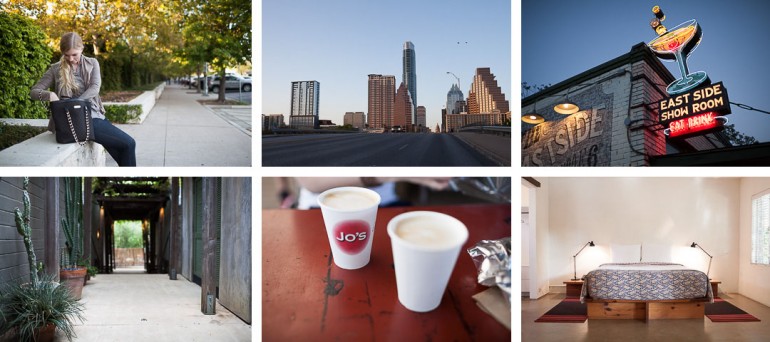
South Congress Avenue and Bridge, East Side Showroom and the San José Hotel (with Jo’s Coffee) in Austin, Texas.
Austin is filled with good bars, great restaurants and great hotels, the people are friendly and things work just like small town but in a big city. A great place to stay is the San José Hotel which provides a beautiful jungle oasis in the middle of the South Congress district within walking distance from the Congress Bridge (the bats!) and the downtown area. Also high up on the list is The Driskill, Hotel Saint Cecilia and of course the W Austin and Westin Austin Downtown if you want to feel like a rock star.
Known as the live music capital of the world, there will certainly be one of more bars playing live music on the E 6th Street every night. But a few of the real gems are a bit away from the bar row. One of the best cocktail bars, with bistro food to match, is the East Side Showroom, but there are many other places to enjoy world class craft cocktails in Austin.
There’s world class gastronomic food at Counter 3. Five. VII (downtown) and Barley Swine (a bit north on the Burnet Road), with a little more modest prices at Foreign & Domestic, located in a little cluster of boutiques and bars (like the Tigress Pub) some bit away from the city center on the West North Loop.
Also worth mentioning when it comes to food is Jo’s Coffee. One of their locations is located, as if by chance, outside the San José Hotel and the other one downtown on 242 W 2nd Street. They have really good coffee and a nice selection of baked goods with some breakfast items and quick bites.
Outside of Austin is the Hamilton Pool, a natural pool with a waterfall located some 30 miles west of Austin. It’s not always open for swimming so check the website for updated status. It’s also usually quite crowded with long lines formed for entering the park. Closer to the city is the Barton Springs Pool.
Lockhart is also not far away, with several iconic barbecue joints. Among them, Smitty’s Market and Kreuz Market which have the same german roots and style and a history dating back to the 1800’s.
Wrapping it up
There are so many locations on this trip where you could easily spend a week on its own and still have room for more things to explore on later visits. For example, leaving out Grand Canyon can seem like a missed opportunity, but this is just what prioritization is all about. Instead we can include Zion National Park as well as Bryce Canyon, and these places not only give more than Grand Canyon does, but the road to getting there is also a destination in its own right.
Doing it in one take can sometimes leave the head hurting from all of the impressions. But taking it, in one go, also has its benefits – discovering the American Southwest can actually be done in one week, and sometimes one week is all you have. Another way of seeing it is that you can add on to this itinerary where needed, take a detour to Phoenix, stay for a few days in Sedona or Bryce Canyon or continue to New Orleans. Or just drive around and eat barbecue for a week in Texas.
The American Southwest has so much to offer and is unique in this world in so many ways. A car is the ideal way to see this part of the world, and whether you have a 4×4 that can explore all the dirt roads, a sports car to enjoy the twisties, a muscle car to power through the open roads or a paltry sedan that simply lets you take in the views, this is one of the worlds ultimate road trips.

